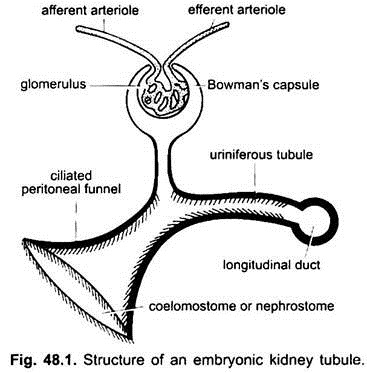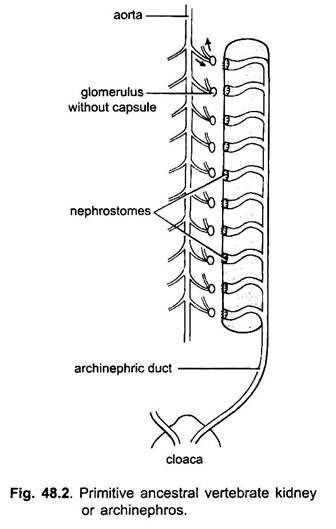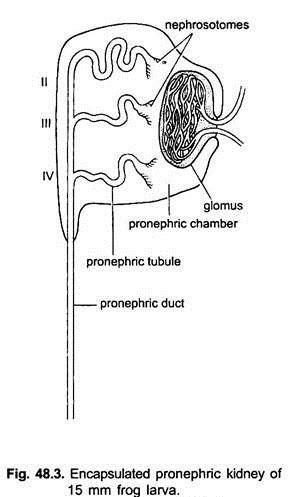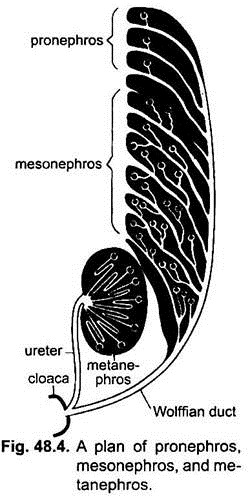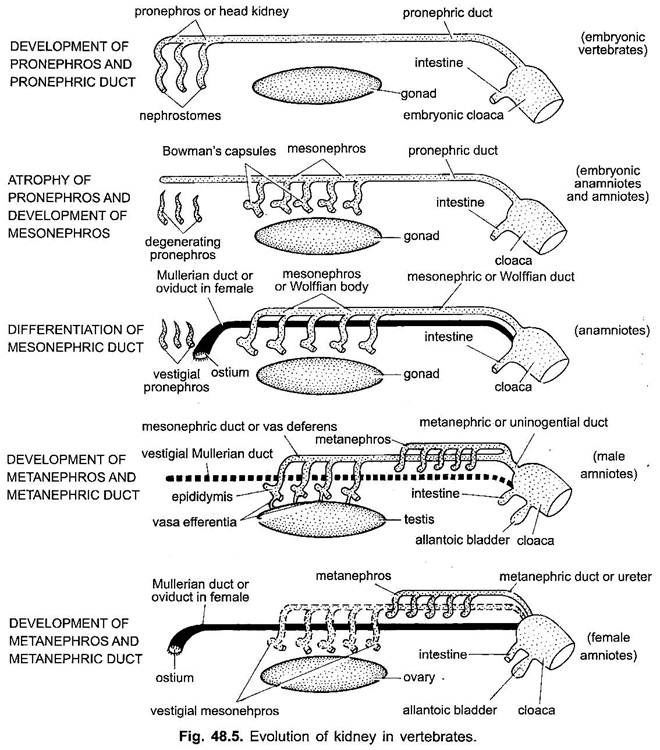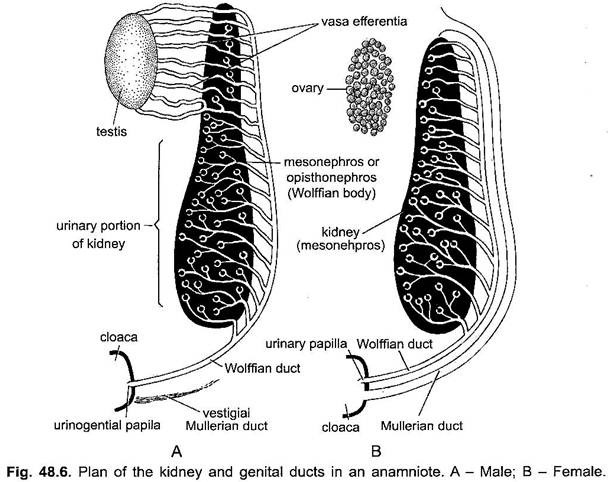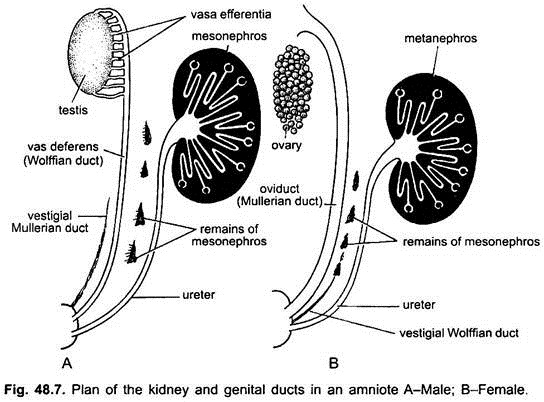Basic Structure:
In vertebrates, there is a pair of compact kidneys, lying dorsal to the coelom in trunk region, one on either side of vertebral column. A kidney is made of a large number of uriniferous tubules or nephrons. Their number, complexity and arrangement is different in different groups of vertebrates.
The uriniferous tubules arise in an embryo from a special part of the mesoderm, called mesomere or nephrotome extending on each side along the entire trunk in between upper segmental mesoderm or epimere and lower lateral plate mesoderm or hypomere. Primitively the uriniferous tubules develop from the nephrotome in a sequence commencing from the anterior end. They are segmental in arrangement with one pair of uriniferous tubules for each trunk segment.
A uriniferous tubule has the following parts:
(i) A ciliated peritoneal funnel near the proximal end of the tubule which opens into the splanchnocoel by a nephrostome or coelomostome (often the peritoneal funnel itself is called a nephrostome).
ADVERTISEMENTS:
(ii) A convoluted ciliated tubule opening into a longitudinal collecting duct, and a Malpighian body or renal corpuscle.
The Malpighian body has a double-walled Bowman’s capsule, enclosing a network of inter-arterial blood capillaries, called glomerulus where filtration of blood takes place. Bowman’s capsule and glomerulus together form the Malpighian body or renal corpuscle. An afferent arteriole brings blood into the glomerulus and an efferent arteriole takes blood away from it. Then the efferent arteriole breaks up into capillaries along the entire course of the uriniferous tubule and finally the blood goes to a renal vein.
Encapsulated glomerulus is internal glomerulus which is common. The glomerulus without a capsule suspended freely in the coelomic cavity is called external glomerulus which is found in embryos and larvae. Malpighian bodies with glomeruli are lacking in some fishes, embryos and larvae and their kidneys are called aglomerular.
ADVERTISEMENTS:
In an adult the uriniferous tubules are elongated and coiled, so that their segmental arrangement is lost and they become enclosed in a connective tissue capsule to form a kidney.
Archinephros:
The ancestral vertebrates had a pair of kidneys running through the entire length of the coelom. Each had segmentally arranged tubules; one pair per body segment. Each tubule opened separately into the coelom by a peritoneal funnel and nephrostome.
Near each funnel was an external glomerulus (without capsule) suspended in coelom. All the tubules of each kidney opened into a common longitudinal duct (Wolffian or archinephric duct) which joined the cloaca. This kidney is called an archinephros or holonephros and its duct is an archinephric duct.
ADVERTISEMENTS:
Among the living vertebrates an archinephros is found only in the larval Myxine and some apodan amphibians. In present-day vertebrates the uriniferous tubules develop antero-posteriorly in two or three stages in succession, these stages are pronephros, mesonephros and metanephros. These stages have evolved from the original archinephros.
Thus, in present vertebrates, kidneys are of three types:
1. Pronephros,
2. Mesonephros and
3. Metanephros.
All three are fundamentally alike, differing principally in their relationship to the blood system, in degree of complexity, and in efficiency.
1. Pronephros:
ADVERTISEMENTS:
Pronephros is the most primitive and while present in the embryonic development of all vertebrates, is functional in the adult of none. Some larval cyclostomes, however, have a kidney, part of which appears to be homologous to the embryonic pronephros of higher vertebrates.
Pronephros develops in the anterior-most part of the nephrotome. There are only 3 to 15 uriniferous tubules in each, one pair to each segment. Near each tubule is a glomerulus projecting into the coelom, which is not connected with the tubule is the external glomerulus. Each tubule opens into coelom by a funnel or nephrostome.
The uriniferous tubules of each pronephros open into a common pronephric duct which grows back to enter the embryonic cloaca. In some, there is a large pronephric chamber which surrounds the glomus (all glomeruli) and tubules.
All glomeruli project into the pronephric chamber where they may unite to form a single compound glomerulus called glomus. Pronephric chamber is derived from pericardial or pleuroperitoneal cavity. All the tubules of a pronephros open into a common pronephric duct opening posteriorly into the embryonic cloaca.
A pair of pronephroi appear in all vertebrate embryos but they become functional kidneys only in some cyclostomes and embryos of all anamniotes. In others they degenerate during development but the pronephric ducts persist. Pronephros is replaced by mesonephros. In those vertebrates in which pronephroi become adult kidneys, they are called head kidneys due to its anterior position behind the head.
2. Mesonephros:
Mesonephros develops from the middle part of the nephrotome behind the pronephros which degenerates. At first it consists of paired segmental uriniferous or mesonephric tubules, each with a peritoneal funnel opening into the coelom and internal glomerulus enclosed in a Bowman’s capsule both are collectively called renal corpuscle. These mesonphric uriniferous tubules join the existing pronephric duct or archinephric duct on each side, which with the disappearance of pronephros is called a mesonephric duct or Wolffian duct.
Later the mesonephric tubules undergo budding to form hundreds of tubules, so that their segmental arrangement is lost. The mesonephric tubules are coiled or convoluted both proximally and distally and lead into a common longitudinal collecting duct the archinephric duct. This in turn leads to the outside, usually by way of the cloaca. Water, salts and waste products from the blood stream pass into the capsule and then may flow through the tubule to the mesonephric duct (original archinephric duct) and ultimately out of the body.
In sharks it functions as a gonadial duct and the kidneys have developed new accessory urinary ducts. The mesonephric tubules have no peritoneal funnels. Mesonephroi form the adult functional kidneys in some cyclostomes, fishes, amphibians and the embryos of amniotes in which they degenerate in the adult. The mesonephroi of amniote embryos lack peritoneal funnels, except in monotremes.
The mesonephros of anamniotes is not exactly equivalent to that of amniote embryos. In anamniotes the mesonephros extends throughout the length of the coelom behind the pronephros and is formed from the entire nephrotome behind the pronephros and is functional both in embryos as well as in adults.
While in adults anurans, urodeles and amniote embryos the mesonephros is formed only from the middle part of the nephrotome and it does not extend throughout the length of the coelom. In sharks and caecilians, the kidney is opisthonephros, i.e., mesonephric tubules extend posteriorly throughout the length of the coelom.
The amphibian kidneys, like those of fishes, are of the opisthonephric type. In tailed amphibians the kidneys are rather elongate structures as in elasmobranchs, but in anurans there is a tendency for these structures to be short and compact.
Renal corpuscles are large to assist in the elimination of water and, thus, prevent excessive dilution of the body fluids. In some amphibians the archinephric duct is both genital and excretory in nature in the male, whereas in others the archinephric duct serves only for the transport of sperms, and the kidney is drained by a new duct, somewhat comparable to the ureter of higher vertebrates.
The kidney of marine fishes, play a major part in maintaining the proper balance with in the body. Salt water tends to dehydrate the body, which is only slightly saline, and it also increases the salt concentration in the body. Freshwater has the opposite effect. Some marine bony fishes have salt-excreting glands on the gills which help to eliminate excessive salt. Most marine fishes, however, other than elasmobranchs, have the renal corpuscles very small so as to reduce water loss.
Since the corpuscle is the filter, the smaller it is the less filtrate passes through. The renal corpuscles are much larger in freshwater fishes than in marine species. This means more liquid output, which is necessary to prevent overdilution of the body fluids. Elasmobranchs, unlike most marine fishes, have large renal corpuscles.
3. Metanephros:
Metanephros is the functional kidney, develops only in amniotes. It is formed from the posterior-most part of the nephrotome behind the embryonic mesonephros which is displaced somewhat anterior and lateral. During embryonic life, however, both pronephros and mesonephros make their appearance.
The metanephros fundamentally resembles the mesonephros, but arises more posteriorly in the body, is more compact and contains a few greater number of renal units. Furthermore, the renal tubules, instead of draining into the archinephric duct open into larger collecting tubules which ultimately lead to a new excretory duct called the ureter.
Metanephric has a double origin, a tubular outgrowth arises from the base of mesonephric duct near the cloaca and it grows anteriorly and dorsally and eventually the metanephric tubules open into it. Its distal end dilates to form the pelvis which divides several times to form collecting tubules, while its proximal part becomes the ureter or metanephric duct. The nephrotome gives rise to metanephric uriniferous tubules of which there are thousands with no segmental arrangement.
The metanephric tubules become long and much coiled and have glomeruli enclosed in Bowman’s capsules but they lack peritoneal funnels so that all connection with the coelom is lost.
Metanephroi are the functional kidneys of adult amniotes and they have achieved the separation of the urinary function from the genital function which appears to be the trend in the evolution of the urinogenital system. In metanephros, the metanephric tubules are much convoluted, and a thin U-shaped loop of Henle is formed in between proximal and distal convolutions of the tubule.
It is absent in reptiles and rudimentary in birds. Kidney is differentiated into outer cortex having renal corpuscles, and inner medulla possessing collecting tubules and loops of Henle. These two aggregated into one or more pyramids projecting into pelvis.
In reptiles, the renal portal system has begun to lose its importance and some of the blood from the caudal region goes directly through the kidneys instead of filtering slowly through the capillary network. In birds, renal portals do not break up into capillaries and are, therefore, not comparable to the renal portals of lower vertebrates. Mammals also lack renal portal system.
In excretion by vertebrate kidneys three processes are involved- a filtration of blood in the glomerulus, secretion of certain waste substances by the cells of uriniferous tubules into the lumen of the tubules, and a selective reabsorption by uriniferous tubules of useful substances from the glomerular filtrate.
In aquatic vertebrates the kidneys are concerned chiefly with elimination of excess water absorbed in the body, and they excrete ammonia well diluted with water, if ammonia is not diluted, it is highly toxic, whereas in terrestrial vertebrates one of the chief functions of the kidneys is to conserve water for maintaining the water balance of the body, and they excrete urea or uric acid. The functioning of kidneys is not under the nervous system but is under the control of several hormones.
Urinary Bladder:
In most vertebrates there is a bag-like urinary bladder serving as a reservoir for urine. In some fishes the bladder is formed by an enlargement of the terminal parts of mesonephric ducts and is used for temporary storage of urine. In amphibians the urinary bladder is derived as a diverticulum from the ventral wall of the cloaca, and not from the proctodaeum, it is lined with endoderm and is called a cloacal bladder.
Urine, thus, first pass from the ducts of the kidneys into the cloacal chamber. From here it is then forced into the bladder for storage. Many reptiles also possess urinary bladder, like that of amphibians, is an outgrowth from the ventral wall of cloaca. It is lacking in crocodilians, snakes and some lizards. The only bird known to possess a bladder is the ostrich. In embryos of amniotes a large bag-like allantois arises from the hindgut.
It serves as an excretory and respiratory organ, in hatching or at birth the allantois is lost but its basal part persists and along with a portion of the cloacal wall it becomes the adult urinary bladder which is endodermal, and is called an allantoic bladder.
Generally the kidney ducts (ureters) do not open into the urinary bladder but open dorsally into the cloaca, except in mammals. In mammals, except monotremes, the ureters open directly into the bladder that opens outside through a short, narrow tube the urethra. Cloaca is not found in mammals except monotremes.
